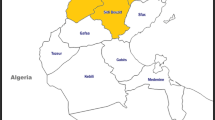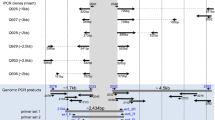Abstract
The polymorphism of major histocompatibility complex class I chain-related gene B (MICB) and variations in MICB alleles in a variety of populations have been characterized using several genotyping approaches. In the present study, a novel polymerase chain reaction sequence-based typing (PCR-SBT) method was established for the genotyping of MICB exons 2–6, and the allelic frequency of MICB in the Zhejiang Han population was investigated. Among 400 unrelated healthy Han individuals from Zhejiang Province, China, a total of 20 MICB alleles were identified, of which MICB*005:02:01, MICB*002:01:01, and MICB*004:01:01 were the most predominant alleles, with frequencies of 0.57375, 0.1225, and 0.08375, respectively. Nine MICB alleles were detected on only one occasion, giving a frequency of 0.00125. Of the 118 distinct MICB ∼ HLA-B haplotypes identified, 42 showed significant linkage disequilibrium (P < 0.05). Haplotypes MICB*005:02:01 ∼ B*46:01, MICB*005:02:01 ∼ B*40:01, and MICB*008 ∼ B*58:01 were the most common haplotypes, with frequencies of 0.0978, 0.0761, and 0.0616, respectively. Five novel alleles, MICB*005:07, MICB*005:08, MICB*027, MICB*028, and MICB*029 were identified. Compared with the MICB*005:02:01 sequence, a G > A substitution was observed at nucleotide position 210 in MICB*005:07, and a 1,134 T > C substitution in MICB*005:08 and an 862 G > A substitution in MICB*027 were detected. In addition, it appears that MICB*028 probably arose from MICB*004:01:01 with an A to G substitution at position 1,147 in exon 6. MICB*029 had a G > T transversion at nucleotide position 730 in exon 4, compared with that of MICB*002:01:01. On the basis of the new PCR-SBT assay, these observed results demonstrated MICB allelic variations in the Zhejiang Han population.
Similar content being viewed by others
Abbreviations
- MICB :
-
Major histocompatibility complex class I chain-related gene B
- LD:
-
Linkage disequilibrium
- PCR-SBT:
-
Polymerase chain reaction sequence-based typing
- HLA-B:
-
Human leukocyte antigen B
- MICA :
-
Major histocompatibility complex class I chain-related gene A
- NK:
-
Natural killer
- 3′UTR:
-
3'untranslated regions
- PCR-SSP:
-
Polymerase chain reaction sequence-specific primer
- PCR-SSO:
-
Polymerase chain reaction sequence-specific oligonucleotide
- LB:
-
Luria-Bertani
- HWE:
-
Hardy–Weinberg equilibrium
References
Abediankenari S, Yousefzadeh Y, Majidi M, Ghasemi M, Nasehi MM, Ghaffari J, Habibi Saravi R, Abedini M, Elyasi M (2011) MICB gene expression on peripheral blood mononuclear cells and susceptibility to multiple sclerosis in north of Iran. Iran J Allergy Asthma Immunol 10:261–265
Ando H, Mizuki N, Ota M, Yamazaki M, Ohno S, Goto K, Miyata Y, Wakisaka K, Bahram S, Inoko H (1997) Allelic variants of the human MHC class I chain-related B gene (MICB). Immunogenetics 46:499–508
Bahram S, Bresnahan M, Geraghty DE, Spies T (1994) A second lineage of mammalian major histocompatibility complex class I genes. Proc Natl Acad Sci USA 91:6259–6263
Bahram S, Shiina T, Oka A, Tamiya G, Inoko H (1996) Genomic structure of the human MHC class I MICB gene. Immunogenetics 45:161–162
Cano P, Klitz W, Mack SJ, Maiers M, Marsh SG, Noreen H, Reed EF, Senitzer D, Setterholm M, Smith A, Fernández-Viña M (2007) Common and well-documented HLA alleles: report of the Ad-Hoc committee of the American society for histocompatibility and immunogenetics. Hum Immunol 68:392–417
Cha CH, Sohn YH, Oh HB, Ko SY, Cho MC, Kwon OJ (2011) MICB polymorphisms and haplotypes with MICA and HLA alleles in Koreans. Tissue Antigens 78:38–44
Chalupny NJ, Rein-Weston A, Dosch S, Cosman D (2006) Downregulation of the NKG2D ligand MICA by the human cytomegalovirus glycoprotein in UL142. Biochem Biophys Res Commun 346:175–181
Collins RW (2004) Human MHC class I chain related (MIC) genes: their biological function and relevance to disease and transplantation. Eur J Immunogenet 31:105–114
Collins RW, Stephens HA, Clare MA, Vaughan RW (2002) High resolution molecular phototyping of MICA and MICB alleles using sequence specific primers. Hum Immunol 63:783–794
del Puerto F, Nishizawa JE, Kikuchi M, Roca Y, Avilas C, Gianella A, Lora J, Velarde FU, Miura S, Komiya N, Maemura K, Hirayama K (2012) Protective human leucocyte antigen haplotype, HLA-DRB1*01-B*14, against chronic Chagas disease in Bolivia. PLoS Negl Trop Dis 6:e1587
Excoffier L, Lischer HE (2010) Arlequin suite ver 3.5: a new series of programs to perform population genetics analyses under Linux and Windows. Mol Ecol Resour 10:564–567
Field SF, Nejentsev S, Walker NM, Howson JM, Godfrey LM, Jolley JD, Hardy MP, Todd JA (2008) Sequencing-based genotyping and association analysis of the MICA and MICB genes in type 1 diabetes. Diabetes 57:1753–1756
Fikri Y, Nyabenda J, Content J, Huygen K (2007) Cloning, sequencing, and cell surface expression pattern of bovine immunoreceptor NKG2D and adaptor molecules DAP10 and DAP12. Immunogenetics 59:653–659
García G, del Puerto F, Pérez AB, Sierra B, Aguirre E, Kikuchi M, Sánchez L, Hirayama K, Guzmán MG (2011) Association of MICA and MICB alleles with symptomatic dengue infection. Hum Immunol 72:904–907
González S, Rodríguez-Rodero S, Martínez-Borra J, López-Vázquez A, Rodrigo L, López-Larrea C (2003) MICB typing by PCR amplification with sequence specific primers. Immunogenetics 54:850–855
Hollenbach JA, Mack SJ, Thomson G, Gourraud PA (2012) Analytical methods for disease association studies with immunogenetic data. Methods Mol Biol 882:245–266
Kato N, Tanaka J, Sugita J, Toubai T, Miura Y, Ibata M, Syono Y, Ota S, Kondo T, Asaka M, Imamura M (2007) Regulation of the expression of MHC class I-related chain A, B (MICA, MICB) via chromatin remodeling and its impact on the susceptibility of leukemic cells to the cytotoxicity of NKG2D-expressing cells. Leukemia 21:2103–2108
Lancaster AK, Single RM, Solberg OD, Nelson MP, Thomson G (2007) PyPop update—a software pipeline for large-scale multilocus population genomics. Tissue Antigens 69(Suppl 1):192–197
Liu X, Li L, Pan F, Tian W (2012) MICB polymorphism is a southern Chinese Han population: the identification of two new MICB alleles, MICB*005:06 and MICB*026. Hum Immunol 73:818–823
Liu X, Tian W, Li L, Cai J (2011) Characterization of the major histocompatibility complex class I chain-related gene B (MICB) polymorphism in a northern Chinese Han population: the identification of a new MICB allele, MICB*023. Hum Immunol 72:727–732
Marsh SG (2012) Nomenclature for factors of the HLA system update July 2012. Tissue Antigens 80:555–559
Mizuki N, Ando H, Kimura M, Ohno S, Miyata S, Yamazaki M, Tashiro H, Watanabe K, Ono A, Taguchi S, Sugawara C, Fukuzumi Y, Okumura K, Goto K, Ishihara M, Nakamura S, Yonemoto J, Kikuti YY, Shiina T, Chen L, Ando A, Ikemura T, Inoko H (1997) Nucleotide sequence analysis of the HLA class I region spanning the 237-kb segment around the HLA-B and -C genes. Genomics 42:55–66
Quiroga I, Lehmann DJ, Barnardo MC, Fuggle S, Cortina-Borja M, Warden DR, Smith AD (2009) Association study of MICA and MICB in Alzheimer's disease. Tissue Antigens 74:241–243
Paschen A, Sucker A, Hill B, Moll I, Zapatka M, Nguyen XD, Sim GC, Gutmann I, Hassel J, Becker JC, Steinle A, Schadendorf D, Ugurel S (2009) Differential clinical significance of individual NKG2D ligands in melanoma: soluble ULBP2 as an indicator of poor prognosis superior to S100B. Clin Cancer Res 15:5208–5215
Rees MT, Downing J, Darke C (2005) A typing system for the major histocompatibility complex class I chain related genes A and B using polymerase chain reaction with sequence-specific primers. Genet Test 9:93–110
Robinson J, Halliwell JA, McWilliam H, Lopez R, Parham P, Marsh SG (2013) The IMGT/HLA database. Nucleic Acids Res 41:D1222–D1227
Stastny P (2006) Introduction: MICA/MICB in innate immunity, adaptive immunity, autoimmunity, cancer, and in the immune response to transplants. Hum Immunol 67:141–144
Shiina T, Tamiya G, Oka A, Yamagata T, Yamagata N, Kikkawa E, Goto K, Mizuki N, Watanabe K, Fukuzumi Y, Taguchi S, Sugawara C, Ono A, Chen L, Yamazaki M, Tashiro H, Ando A, Ikemura T, Kimura M, Inoko H (1998) Nucleotide sequencing analysis of the 146-kilobase segment around the IkBL and MICA genes at the centromeric end of the HLA class I region. Genomics 47:372–382
Tosh K, Ravikumar M, Bell JT, Meisner S, Hill AV, Pitchappan R (2006) Variation in MICA and MICB genes and enhanced susceptibility to paucibacillary leprosy in South India. Hum Mol Genet 15:2880–2887
Unni AM, Bondar T, Medzhitov R (2008) Intrinsic sensor of oncogenic transformation induces a signal for innate immunosurveillance. Proc Natl Acad Sci USA 105:1686–1691
Weiss-Steider B, Soto-Cruz I, Martinez-Campos CA, Mendoza-Rin JF (2011) Expression of MICA, MICB, and NKG2D in human leukemic myelomonocytic and cervical cancer cells. Exp Clin Cancer Res 10:30–37
Zhu F, He Y, Zhang W, He J, He J, Xu X, Lv H, Yan L (2011) Analysis for complete genomic sequence of HLA-B and HLA-C alleles in the Chinese Han population. Int J Immunogenet 38:281–284
Zhu FM, He J, Wang W, Lv HJ, Yan LX (2010) Identification of a novel allele HLA-B*35:137 in a Chinese leukemia patient. Tissue Antigens 76:498–499
Acknowledgments
This work was sponsored by the Zhejiang Provincial Program for the Cultivation of High-Level Innovative Health Talents, and by the Science Research Foundation of the Zhejiang Health Bureau (2010KYA055, 2011ZDA005).
Conflict of Interest
There are no conflicts of interest in the preparation of this manuscript. The authors certify that they have no affiliation with or financial involvement in any organization or entity with a direct financial interest in the subject matter or in materials discussed in this manuscript.
Author information
Authors and Affiliations
Corresponding author
Rights and permissions
About this article
Cite this article
Ying, Y., He, Y., Tao, S. et al. Distribution of MICB diversity in the Zhejiang Han population: PCR sequence-based typing for exons 2–6 and identification of five novel MICB alleles. Immunogenetics 65, 485–492 (2013). https://doi.org/10.1007/s00251-013-0699-4
Received:
Accepted:
Published:
Issue Date:
DOI: https://doi.org/10.1007/s00251-013-0699-4




